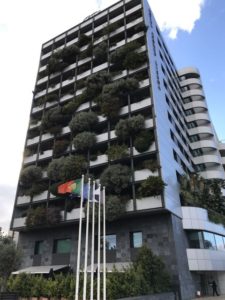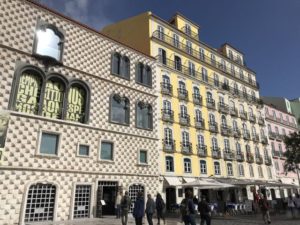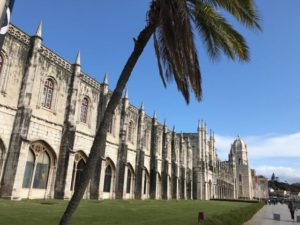We arrived in Lisbon in the early afternoon at the Hotel Azores Lisbon, a lovely modern hotel above the old town.  We found a local restaurant for lunch and then picked up a hop on and off bus and toured Belém and most of the old city.
We found a local restaurant for lunch and then picked up a hop on and off bus and toured Belém and most of the old city.
Lisbon is a large city and we were glad not to be trying to walk from one end of the city to another. It was too late in the day and we were too tired to stop at any of the Belém monuments so we went back to our hotel and had a nice meal there, roast duck and wild mushroom risotto.
The next day, Thursday, we headed out early to take the metro downtown to pick up a walking tour at the Praça Luís de Camoes. The metro was right outside our hotel but the metro machines were hard to figure out. Luckily, two very kind Lisbon folks took time to help us buy metro tickets. We took the Chill Out Lisbon tour which was much smaller than one of the other tours that met in the same square.. I can’t imagine a better tour.. our tour guide, Emily, was a PhD student and knew her history backwards and forwards and presented it all in a very entertaining fashion.
We learned so much about the three thousand year history of Lisbon starting with the Phonicians to the Moors (the two largest influences on the language and culture).
We learned that the 1755 earthquake destroyed 80% of Lisbon and how the city was rebuilt by the Marquis of Pombal while the king camped in an elaborate tent outside of town for the rest of his life. We learned about the dictatorship that ruled the country from 1926 to 74 and was overthrown in a bloodless revolution known as the carnation revolution because the soldiers put carnations in their guns and refused to fire on the people. We also learned that over one million young people left the country after the 2008 economic crisis because there was no work.
The tour took us to five of the older neighborhoods. Rain was predicted, so we were prepared. We had showers on and off during the 3 hour tour, but the sun kept coming out.
 My favorite neighborhood was the Alfama, 1200 years old, originally settled by the Moors, but latter during the Inqusition, it became the Jewish ghetto. It stretches from the King George castle down to the sea. It is all uphill. Our guide says it is still a neighborhood where people know one another. It is charming with its narrow cobbled streets and restaurants.
My favorite neighborhood was the Alfama, 1200 years old, originally settled by the Moors, but latter during the Inqusition, it became the Jewish ghetto. It stretches from the King George castle down to the sea. It is all uphill. Our guide says it is still a neighborhood where people know one another. It is charming with its narrow cobbled streets and restaurants.
 It’s also the area to hear fado, Portuguese blues. We planned to come back tonight but never made it.
It’s also the area to hear fado, Portuguese blues. We planned to come back tonight but never made it.
After the tour, we walked up to St George castle ( and saw window musicians on the way up).
 We had a wonderful lunch in a restaurant Emily recommended, O Satellite. Dorota got her grilled octopus and I got to try pork with clams Alentejo.
We had a wonderful lunch in a restaurant Emily recommended, O Satellite. Dorota got her grilled octopus and I got to try pork with clams Alentejo.
After lunch we rode the famous 28 tram down to the sea (with three kids hanging on to the outside of the tram) We picked up a tram to Belém, but the automatic reader wouldn’t read our tickets, so we got off ( a mistake because we were legal) and walked about three miles toward Belém only to realize everything would be closed by the time we got there.
We caught a yellow bus back to our hotel. The hop on and off yellow bus wasn’t a good idea because they don’t have enough stops and the audio didn’t work well. The walking tour was fantastic, however.
On our last day, we were determined to see the monuments in Belem, so we took the yellow bus back down to Belem. We saw the Tower of Belem (once a prison) and the monument to the discoverers. 

The San Jeronimo Monastery had very long lines to get in, so we enjoyed the maritime museum and took pictures of the outside.
 We returned our rental car in the nick of time and caught our 5 pm flight back to New York, where we enjoyed more good food and a visit to MOMA.
We returned our rental car in the nick of time and caught our 5 pm flight back to New York, where we enjoyed more good food and a visit to MOMA.












